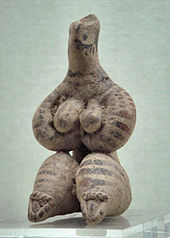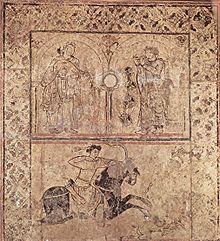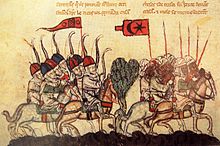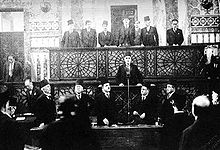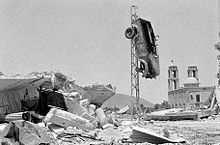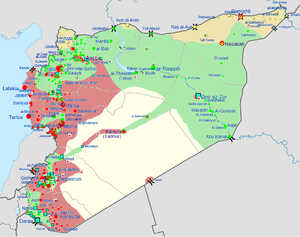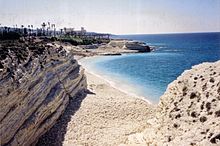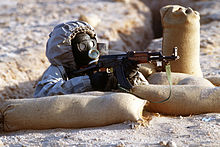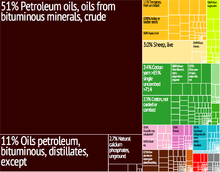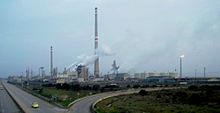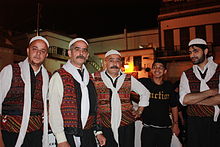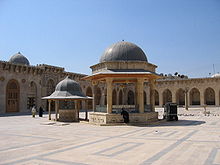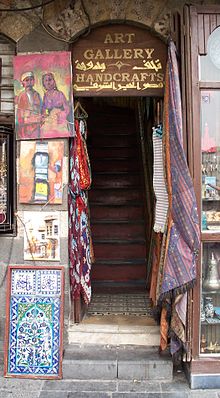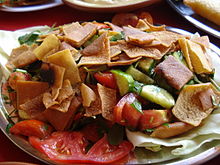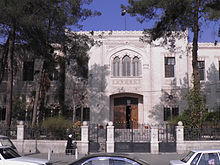
Syria
Background to the schools Wikipedia
This Schools selection was originally chosen by SOS Children for schools in the developing world without internet access. It is available as a intranet download. Before you decide about sponsoring a child, why not learn about different sponsorship charities first?
| Syrian Arab Republic الجمهورية العربية السورية
Al-jumhuryah Al-arabia as-suriah |
||||||
|---|---|---|---|---|---|---|
|
||||||
| Anthem: Homat el Diyar Guardians of the Land |
||||||
|
|
||||||
| Capital | Damascus 33°30′N 36°18′E |
|||||
| Largest city | Aleppo | |||||
| Official languages | Arabic | |||||
| Government | Dominant-party unitary semi-presidential state |
|||||
| - | President | Bashar al-Assad | ||||
| - | Prime Minister | Wael Nader al-Halqi | ||||
| - | Speaker of the People's Council | Mohammad Jihad al-Laham | ||||
| Legislature | People's Council | |||||
| Establishment | ||||||
| - | Independence from Ottoman Empire | 1 September 1918 | ||||
| - | Independence from France | 17 April 1946 | ||||
| - | Secession from the United Arab Republic |
28 September 1961 | ||||
| Area | ||||||
| - | Total | 186,475 km2 ( 89th) 71,479 sq mi |
||||
| - | Water (%) | 1.1 | ||||
| Population | ||||||
| - | July 2012 estimate | 22,530,746 ( 53rd) | ||||
| - | Density | 118.3/km2 ( 101st) 306.5/sq mi |
||||
| GDP ( PPP) | 2012 estimate | |||||
| - | Total | $107.831 billion | ||||
| - | Per capita | $5,100 | ||||
| GDP (nominal) | 2010 estimate | |||||
| - | Total | $59.957 billion | ||||
| - | Per capita | $2,802 | ||||
| Gini (2004) | 35.8 medium |
|||||
| HDI (2011) | medium · 119th |
|||||
| Currency | Syrian pound ( SYP) |
|||||
| Time zone | EET ( UTC+2) | |||||
| - | Summer ( DST) | EEST ( UTC+3) | ||||
| Drives on the | right | |||||
| Calling code | +963b | |||||
| ISO 3166 code | SY | |||||
| Internet TLD | .sy | |||||
| a. | Arabic is the official language. Spoken languages and varieties are: Syrian Arabic, North Mesopotamian Arabic, Kurmanji Kurdish, Armenian, Aramaic, Circassian, Turkish and Russian. | |||||
| b. | 02 from Lebanon. | |||||
Syria ( / ˈ s ɪr i ə / SIRR-ee-ə ; Arabic: سوريا / ALA-LC: Sūriyā, or سورية / Sūrīyah; Syriac: ܣܘܪܝܐ; Kurdish: سوریه, Sûrî), officially the Syrian Arab Republic, is a country in Western Asia, bordering Lebanon and the Mediterranean Sea to the West, Turkey to the north, Iraq to the east, Jordan to the south and Israel to the southwest. A country of fertile plains, high mountains and deserts, it is home to diverse ethnic and religious groups, including Kurds, Armenians, Assyrians, Turks, Christians, Druze, Alawite Shias and Arab Sunnis. The latter make up the majority of the population.
In English, the name "Syria" was formerly synonymous with the Levant (known in Arabic as al-Sham) while the modern state encompasses the sites of several ancient kingdoms and empires, including the Eblan civilization of the third millennium BC. In the Islamic era, its capital city, Damascus, the oldest continuously inhabited city in the world, was the seat of the Umayyad Caliphate, and a provincial capital of the Mamluk Sultanate of Egypt.
The modern Syrian state was established after the First World War as a French mandate, and represented the largest Arab state to emerge from the formerly Ottoman-ruled Arab Levant. It gained independence in April 1946, as a parliamentary republic. The post-independence period was tumultuous, and a large number of military coups and coup attempts shook the country in the period 1949–1971. Between 1958 and 1961, Syria entered a brief union with Egypt, which was terminated by a military coup. Syria was under Emergency Law from 1963 to 2011, effectively suspending most constitutional protections for citizens, and its system of government is considered to be non-democratic. Bashar al-Assad has been president since 2000 and was preceded by his father Hafez al-Assad, who was in office from 1970 to 2000.
Syria is a member of one International organization other than the United Nations, the Non-Aligned Movement; it is currently suspended from the Arab League, the Organisation of Islamic Cooperation, and self suspended from the Union for the Mediterranean.
Since March 2011, Syria has been embroiled in civil war in the wake of uprisings (considered an extension of the Arab Spring, the mass movement of revolutions and protests in the Arab world) against Assad and the neo-Ba'athist government. An alternative government that was formed by the opposition umbrella group, the Syrian National Coalition, in March 2012. Representatives of this government were subsequently invited to take up Syria's seat at the Arab League. The opposition coalition has been recognised as the "sole representative of the Syrian people" by several nations including the United States, United Kingdom and France.
Etymology
The name Syria is derived from the ancient Greek name for Syrians: Σύριοι, Sýrioi, or Σύροι, Sýroi, which the Greeks applied without distinction to the Assyrians. A number of modern scholars argued that the Greek word related to the cognate Ἀσσυρία, Assyria, ultimately derived from the Akkadian Aššur. Others believed that it was derived from Siryon, the name that the Sidonians gave to Mount Hermon. However, the discovery of the Çineköy inscription in 2000 seems to support the theory that the term Syria derives from Assyria.
The area designated by the word has changed over time. Classically, Syria lies at the eastern end of the Mediterranean, between Arabia to the south and Asia Minor to the north, stretching inland to include parts of Iraq, and having an uncertain border to the northeast that Pliny the Elder describes as including, from west to east, Commagene, Sophene, and Adiabene.
By Pliny's time, however, this larger Syria had been divided into a number of provinces under the Roman Empire (but politically independent from each other): Judaea, later renamed Palaestina in AD 135 (the region corresponding to modern day Israel, the Palestinian Territories, and Jordan) in the extreme southwest, Phoenicia corresponding to Lebanon, with Damascena to the inland side of Phoenicia, Coele-Syria (or "Hollow Syria") south of the Eleutheris river, and Iraq.
History
Since approximately 10,000 BC, Syria was one of centers of Neolithic culture (known as Pre-Pottery Neolithic A) where agriculture and cattle breeding appeared for the first time in the world. The following Neolithic period ( PPNB) is represented by rectangular houses of Mureybet culture. At the time of the pre-pottery Neolithic, people used vessels made of stone, gyps and burnt lime ( Vaiselles blanches). Finds of obsidian tools from Anatolia are evidences of early trade relations. Cities of Hamoukar and Emar played an important role during the late Neolithic and Bronze Age. Archaeologists have demonstrated that civilization in Syria was one of the most ancient on earth.
Around the excavated city of Ebla near Idlib in northern Syria, a great Semitic empire spread from the Red Sea north to Anatolia and east to Iraq from 2500 to 2400 BC. Ebla appears to have been founded around 3000 BC, and gradually built its empire through trade with the cities of Sumer and Akkad, as well as with peoples to the northwest. Gifts from Pharaohs, found during excavations, confirm Ebla's contact with Egypt. Scholars believe the language of Ebla to be among the oldest known written Semitic languages, designated as Paleo-Canaanite.
However, more recent classifications of the Eblaite language have shown that it was an East Semitic language, closely related to the Akkadian language. The Eblan civilization was likely conquered by Sargon of Akkad around 2260 BC; the city was restored, as the nation of the Amorites, a few centuries later, and flourished through the early second millennium BC until conquered by the Hittites.
Antiquity and Christian Syria
During the second millennium BC, Syria was occupied successively by Canaanites, Phoenicians, and Arameans as part of the general disruptions and exchanges associated with the Sea Peoples. The Phoenicians settled along the coast of Northern Canaan (Lebanon). Egyptians, Sumerians, Assyrians, Babylonians and Hittites variously occupied the strategic ground of Syria during this period; the land between their various empires being marsh.
Eventually, the Persians took Syria as part of their hegemony of Southwest Asia; this dominion was transferred to the Ancient Macedonians and Greeks after Alexander the Great's conquests and the Seleucid Empire. Pompey the Great captured Antioch in 64 BC, turning Syria into a Roman province. Thus control of this region passed to the Romans and then the Byzantines.
The population of Syria during the heyday of the empire was probably not exceeded again until the 19th century. Syria's large and prosperous population made Syria one of the most important of the Roman provinces, particularly during the 2nd and 3rd centuries (AD).
The Roman Emperor Alexander Severus, who was emperor from 222 to 235, was Syrian. His cousin Elagabalus, who was emperor from 218 to 222, was also Syrian and his family held hereditary rights to the high priesthood of the sun god El-Gabal at Emesa (modern Homs) in Syria. Another Roman emperor who was a Syrian was Philip the Arab (Marcus Julius Philippus), emperor from 244 to 249.
Syria is significant in the history of Christianity; Saulus of Tarsus, better known as the Apostle Paul, was converted on the Road to Damascus and emerged as a significant figure in the Christian Church at Antioch in ancient Syria, from which he left on many of his missionary journeys. ( Acts 9:1–43 )
Islamic Syria
By AD 640, Syria was conquered by the Rashidun army led by Khalid ibn al-Walid. In the mid-7th century, the Umayyad dynasty, then rulers of the empire, placed the capital of the empire in Damascus. The country's power dramatically declined during later Umayyad rule; due mainly to the totalitarianism, corruption and the resulting revolutions by the oppressed. The Umayyad dynasty was then overthrown in 750 by the Abbasid dynasty, which moved the capital of empire to Baghdad.
Arabic — made official under Umayyad rule — became the dominant language, replacing Greek and Aramaic in the Abbasid era. In 887, the Egypt-based Tulunids annexed Syria from the Abbasids, and were later replaced by once the Egypt-based Ikhshidids and still later by the Hamdanids originating in Aleppo founded by Sayf al-Dawla.
Sections of the coastline of Syria were briefly held by Frankish overlords during the Crusades of the 12th century, and were known collectively as the Crusader state of the Principality of Antioch. The area was also threatened by Shi'a extremists known as Assassins (Hassassin). Aleppo fell to the Mongols of Hulegu in January 1260, and Damascus in March, but then Hulegu needed to break off his attack to return to China to deal with a succession dispute.
A few months later, the Mamluks arrived with an army from Egypt and defeated the Mongols in the Battle of Ain Jalut in Galilee. The Mamluk leader, Baibars, made Damascus a provincial capital. When he died, power was taken by Qalawun. In the meantime, an emir named Sunqur al-Ashqar had tried to declare himself ruler of Damascus, but he was defeated by Qalawun on 21 June 1280, and fled to northern Syria. Al-Ashqar, who had married a Mongol woman, appealed for help from the Mongols. The Mongols of the Ilkhanate took the city, but Qalawun persuaded Al-Ashqar to join him, and they fought against the Mongols on 29 October 1281, in the Second Battle of Homs, which was won by the Mamluks.
In 1400, Timur Lenk, invaded Syria, sacked Aleppo and captured Damascus after defeating the Mamluk army. The city's inhabitants were massacred, except for the artisans, who were deported to Samarkand. By the end of the 15th century, the discovery of a sea route from Europe to the Far East ended the need for an overland trade route through Syria.
Ottoman Syria
In 1516, the Ottoman Empire invaded the Mamluk Sultanate of Egypt, conquering Syria, and incorporating it into its empire. The Ottoman system was not burdensome to Syrians because the Turks respected Arabic as the language of the Koran, and accepted the mantle of defenders of the faith. Damascus was made the major entrepot for Mecca, and as such it acquired a holy character to Muslims, because of the baraka (spiritual force or blessing) of the countless pilgrims who passed through on the hajj, the pilgrimage to Mecca.
Ottoman administration followed a unique system that lead to a peaceful coexistence for centuries. Each religious minority — Shia Muslim, Greek Orthodox, Maronite, Armenian, and Jewish—constituted a millet. The religious heads of each community administered all personal status law and performed certain civil functions as well.
In the midst of World War I, two Allied diplomats (Frenchman François Georges-Picot and Briton Mark Sykes) secretly agreed on the post-war division of the Ottoman Empire into respective zones of influence in the Sykes-Picot Agreement of 1916. Initially, the two territories were separated by a border that ran in an almost straight line from Jordan to Iran. However, the discovery of oil in the region of Mosul just before the end of the war led to yet another negotiation with France in 1918 to cede this region to 'Zone B', or the British zone of influence. This border was later recognized internationally when Syria became a League of Nations mandate in 1920 and has not changed to this date.
French Mandate
In 1920, a short-lived independent Kingdom of Syria was established under Faisal I of the Hashemite family. However, his rule over Syria ended after only a few months, following the Battle of Maysalun. French troops occupied Syria later that year after the San Remo conference proposed that the League of Nations put Syria under a French mandate.
In 1925, Sultan al-Atrash led a revolt that broke out in the Druze Mountain and spread to engulf the whole of Syria and parts of Lebanon. Al-Atrash won several battles against the French, notably the Battle of al-Kafr on 21 July 1925, the Battle of al-Mazraa on 2–3 August 1925, and the battles of Salkhad, al-Musayfirah and Suwayda. France sent thousands of troops from Morocco and Senegal, leading the French to regain many cities, although resistance lasted until the spring of 1927. The French sentenced Sultan al-Atrash to death, but he had escaped with the rebels to Transjordan and was eventually pardoned. He returned to Syria in 1937 after the signing of the Syrian-French Treaty.
Syria and France negotiated a treaty of independence in September 1936, and Hashim al-Atassi was the first president to be elected under the first incarnation of the modern republic of Syria. However, the treaty never came into force because the French Legislature refused to ratify it. With the fall of France in 1940 during World War II, Syria came under the control of Vichy France until the British and Free French occupied the country in the Syria-Lebanon campaign in July 1941. Continuing pressure from Syrian nationalists and the British forced the French to evacuate their troops in April 1946, leaving the country in the hands of a republican government that had been formed during the mandate.
Independence
Upheaval dominated Syrian politics from independence through the late 1960s: in 1948, Syria was involved in the Arab-Israeli War, aligning with the other local Arab states who were attempting to prevent the establishment of the State of Israel. This defeat was one of several trigger factors for the March 1949 Syrian coup d'état by Col. Husni al-Za'im, described as the first military overthrow of the Arab World since the start of the Second World War. This was soon followed by another overthrow, by Col. Sami al-Hinnawi, who was himself quickly deposed by Col. Adib Shishakli, all within the same year.
Shishakli eventually abolished multipartyism altogether, but was himself overthrown in a 1954 coup and the parliamentary system was restored, but by this time, power was increasingly concentrated in the military and security establishment. The weakness of parliamentary institutions and the mismanagement of the economy, as well as the influence of Nasserism and other ideologies, created fertile ground for various Arab nationalist, Syrian nationalist, and socialist movements, which represented disaffected elements of society, notably including religious minorities, and demanded radical reform.
In November 1956, as a direct result of the Suez Crisis, Syria signed a pact with the Soviet Union, providing a foothold for Communist influence within the government in exchange for military equipment. This increase in the strength of Syrian military technology worried Turkey, as it seemed feasible that Syria might attempt to retake İskenderun. Only heated debates in the United Nations lessened the threat of war.
On 1 February 1958, Syrian President Shukri al-Quwatli and Egypt's Nasser announced the merging of Egypt and Syria, creating the United Arab Republic, and all Syrian political parties, as well as the communists therein, ceased overt activities. Meanwhile, a group of Syrian Ba'athist officers, alarmed by the party’s poor position and the increasing fragility of the union, decided to form a secret Military Committee; its initial members were Lieutenant-Colonel Muhammad Umran, Major Salah Jadid and Captain Hafez al-Assad. When Syria seceded on 28 September 1961, the ensuing instability culminated in the 8 March 1963 coup. The takeover was engineered by members of the Arab Socialist Ba'ath Party, led by Michel Aflaq and Salah al-Din al-Bitar. The new cabinet was dominated by Ba'ath members.
Ba'athist Syria
On 23 February 1966, the Military Committee carried out an intra-party overthrow, imprisoned President Amin Hafiz and designated a regionalist, civilian Ba'ath government on 1 March. Although Nureddin al-Atassi became the formal head of state, Salah Jadid was Syria's effective ruler from 1966 until 1970. The coup led to a split within the original pan-Arab Ba'ath Party: one Iraqi-led ba'ath movement (ruled Iraq from 1968 to 2003) and one Syrian-led ba'ath movement was established.
Conflict over the cultivation of disputed lands sparked into 7 April prewar aerial clashes between Israel and Syria. After Israel launched a preemptive strike on Egypt to begin the June 1967 war, Syria joined the battle against Israel as well. In the final days of the war, Israel turned its attention to Syria, capturing the entire Golan Heights in under 48 hours. The defeat caused a split between Jadid and Assad over what steps to take next.
Disagreement developed between Jadid, who controlled the party apparatus, and Assad, who controlled the military. The 1970 retreat of Syrian forces sent to aid the PLO during the " Black September" hostilities with Jordan reflected this disagreement. The power struggle culminated in the November 1970 Corrective Movement, a bloodless military overthrow that installed Hafez al-Assad as the strongman of the government.
On 6 October 1973, Syria and Egypt initiated the Yom Kippur War against Israel. The Israel Defense Forces reversed the initial Syrian gains and pushed deeper into Syrian territory.
In early 1976, Syria entered Lebanon, beginning the thirty-year Syrian military occupation. Over the following 15 years of civil war, Syria fought for control over Lebanon, and attempted to stop Israel from taking over in southern Lebanon, through extensive use of proxy militias. Syria then remained in Lebanon until 2005.
In the late 1970s, an Islamic uprising by the Muslim Brotherhood was aimed against the government. Islamists attacked civilians and off-duty military personnel, and civilians were also killed in retaliatory strike by security forces. The uprising had reached its climax in the 1982 Hama massacre, when some 10,000 - 40,000 people were killed by regular Syrian Army troops.
In a major shift in relations with both other Arab states and the Western world, Syria participated in the US-led Gulf War against Saddam Hussein. Syria participated in the multilateral Madrid Conference of 1991, and during the 1990s engaged in negotiations with Israel. These negotiations failed, and there have been no further direct Syrian-Israeli talks since President Hafez al-Assad's meeting with then President Bill Clinton in Geneva in March 2000.
Hafez al-Assad died on 10 June 2000. His son, Bashar al-Assad, was elected President in an election in which he ran unopposed. His election saw the birth of the Damascus Spring and hopes of reform, but by autumn 2001 the authorities had suppressed the movement, imprisoning some of its leading intellectuals. Instead, reforms have been limited to some market reforms.
On 5 October 2003, Israel bombed a site near Damascus, claiming it was a terrorist training facility for members of Islamic Jihad. In March 2004, Syrian Kurds and Arabs clashed in the northeastern city of al-Qamishli. Signs of rioting were seen in the towns of Qameshli and Hassakeh. In 2005, Syria ended its occupation of Lebanon. On 6 September 2007, Israeli jet fighters carried out Operation Orchard against a suspected nuclear reactor under construction by North Korean technicians.
The ongoing Syrian civil war was inspired by the Arab Spring Revolutions. It began in 2011 as a chain of peaceful protests, followed by a crackdown by the Syrian Army. In July 2011, army defectors declared the formation of the Free Syrian Army and began forming fighting units. The opposition is dominated by Sunni Muslims, whereas the leading government figures are Alawites. According to various sources, including the United Nations, up to 60,000 people have been killed. To escape the violence, over 650,000 Syrian refugees have fled to neighboring countries of Jordan, Iraq, Lebanon, and Turkey. As the civil war nears its second year, there have been worries that the country could become fragmented and cease to function as a state.
Geography
Syria lies between latitudes 32° and 38° N, and longitudes 35° and 43° E. It consists mostly of arid plateau, although the northwest part of the country bordering the Mediterranean is fairly green. The Northeast of the country "Al Jazira" and the South "Hawran" are important agricultural areas. The Euphrates, Syria's most important river, crosses the country in the east. It is considered to be one of the fifteen states that comprise the so-called " Cradle of civilization".
The climate in Syria is dry and hot, and winters are mild. Because of the country's elevation, snowfall does occasionally occur during winter. Petroleum in commercial quantities was first discovered in the northeast in 1956. The most important oil fields are those of Suwaydiyah, Qaratshui, Rumayian, and Tayyem, near Dayr az–Zawr. The fields are a natural extension of the Iraqi fields of Mosul and Kirkuk. Petroleum became Syria's leading natural resource and chief export after 1974. Natural gas was discovered at the field of Jbessa in 1940.
Politics and government
Syria is formally a unitary republic. The constitution adopted in 2012 effectively transformed Syria into a semi-presidential republic due to the constitutional right for individuals to be elected which do not form part of the National Progressive Front. The President is Head of State and the Prime Minister is Head of Government. The Peoples Council is the Syria's legislature responsible for passing laws, approving government appropriations and debating policy. In the event of a vote of no confidence by a simple majority, the Prime Minister is required to tender the resignation of their government to the President.
The executive branch consists of the president, two vice presidents, the prime minister, and the Council of Ministers (cabinet). The constitution requires the president to be a Muslim but does not make Islam the state religion.
The constitution gives the president the right to appoint ministers, to declare war and state of emergency, to issue laws (which, except in the case of emergency, require ratification by the People's Council), to declare amnesty, to amend the constitution, and to appoint civil servants and military personnel. According to the 2012 constitution, the president is elected by Syrian citizens in a direct election.
Syria's legislative branch is the unicameral People's Council. Under the previous constitution, Syria did not hold multi-party elections for the legislature, with two thirds of the seats automatically allocated to the ruling coalition. On 7 May 2012, Syria held its first elections in which parties outside the ruling coalition could take part. Seven new political parties took part in the elections, of which Popular Front for Change and Liberation was the largest opposition party. The armed anti-government rebels, however, chose not to field candidates and called on their supporters to boycott the elections.
The President is the Secretary-General of the party, and the leader of the National Progressive Front governing coalition. Outside of the coalition are 14 illegal Kurdish political parties.
Syria's judicial branches include the Supreme Constitutional Court, the High Judicial Council, the Court of Cassation, and the State Security Courts. Islamic jurisprudence is a main source of legislation and Syria's judicial system has elements of Ottoman, French, and Islamic laws. Syria has three levels of courts: courts of first instance, courts of appeals, and the constitutional court, the highest tribunal. Religious courts handle questions of personal and family law. The Supreme State Security Court (SSSC) was abolished by President Bashar al-Assad by legislative decree No. 53 on 21 April 2011.
The Personal Status Law 59 of 1953 (amended by Law 34 of 1975) is essentially a codified sharia. Article 3(2) of the 1973 constitution declares Islamic jurisprudence a main source of legislation. The Code of Personal Status is applied to Muslims by sharia courts.
Syrian National Coalition
As a result of the ongoing civil war, an alternative government was formed by the opposition umbrella group, the Syrian National Coalition, in March 2012. Representatives of this government were invited to take up Syria's seat at the Arab League on 28 March 2013. The opposition coalition has been recognised as the "sole representative of the Syrian people" by several nations including the United States, United Kingdom and France.
Military
The President of Syria is commander in chief of the Syrian armed forces, comprising some 400,000 troops upon mobilization. The military is a conscripted force; males serve in the military upon reaching the age of 18. The obligatory military service period is being decreased over time, in 2005 from two and a half years to two years, in 2008 to 21 months and in 2011 to year and a half. About 20,000 Syrian soldiers were deployed in Lebanon until 27 April 2005, when the last of Syria's troops left the country after three decades.
The breakup of the Soviet Union — long the principal source of training, material, and credit for the Syrian forces — may have slowed Syria's ability to acquire modern military equipment. It has an arsenal of surface-to-surface missiles. In the early 1990s, Scud-C missiles with a 500-kilometer range were procured from North Korea, and Scud-D, with a range of up to 700 kilometers, is allegedly being developed by Syria with the help of North Korea and Iran, according to Zisser.
Syria received significant financial aid from Persian Gulf Arab states as a result of its participation in the Persian Gulf War, with a sizable portion of these funds earmarked for military spending.
Foreign relations
Ensuring national security, increasing influence among its Arab neighbors, and securing the return of the Golan Heights, are the primary goals of President Bashar al-Assad's foreign policy. At many points in its history, Syria has seen virulent tension with its geographically cultural neighbors, such as Turkey, Israel, Iraq, and Lebanon. Syria enjoyed an improvement in relations with several of the states in its region in the 21st century, prior to the Arab Spring and the Syrian civil war.
Since the ongoing civil war of 2011, and associated killings and human rights abuses, Syria has been increasingly isolated from the countries in the region, and the wider international community. Diplomatic relations have been severed with several countries including: Britain, Canada, France, Italy, Germany, Tunisia, Egypt, Libya, United States, Belgium, Spain, and the Gulf States.
From the Arab league, Syria continues to maintain diplomatic relations with Yemen, Lebanon, Sudan, and Iraq. Syria's violence against civilians has also seen it suspended from the Arab League and the Organisation of Islamic Cooperation in 2012. Syria continues to foster good relations with her traditional allies, Iran, China, and Russia, who are among the few countries which have supported the Syrian government in its conflict with the Syrian opposition.
Syria considers the Hatay Province of Turkey as part of its own territory.
Israel unilaterally annexed the Golan Heights in 1981, although the Syrian government continues to demand the return of this territory.
The Syrian occupation of Lebanon began in 1976 as a result of the civil war and ended in April 2006 in response to domestic and international pressure after the assassination of former Lebanese Prime Minister, Rafik Hariri.
Administrative divisions
Syria is divided into 14 governorates, which are sub-divided into 61 districts, which are further divided into sub-districts.
| No. | Governorate | Capital | |
|---|---|---|---|
| 1 | Latakia | Latakia | |
| 2 | Idlib | Idlib | |
| 3 | Aleppo | Aleppo | |
| 4 | Al-Raqqah | Al-Raqqah | |
| 5 | Al-Hasakah | Al-Hasakah | |
| 6 | Tartus | Tartus | |
| 7 | Hama | Hama | |
| 8 | Deir ez-Zor | Deir ez-Zor | |
| 9 | Homs | Homs | |
| 10 | Damascus | – | |
| 11 | Rif Dimashq | Douma | |
| 12 | Quneitra | Quneitra | |
| 13 | Daraa | Daraa | |
| 14 | Al-Suwayda | Al-Suwayda |
Economy
Syria is classified by the World Bank as a "lower middle income country." Syria remains dependent on the oil and agriculture sectors. The oil sector provides about 40% of export earnings. The agriculture sector contributes to about 20% of GDP and 20% of employment. Oil reserves are expected to decrease in the coming years and Syria has already become a net oil importer.
The economy is highly regulated by the government, which has increased subsidies and tightened trade controls to assuage protesters and protect foreign currency reserves. Long-run economic constraints include foreign trade barriers, declining oil production, high unemployment, rising budget deficits, and increasing pressure on water supplies caused by heavy use in agriculture, rapid population growth, industrial expansion, and water pollution. The UNDP announced in 2005 that 30% of the Syrian population lives in poverty and 11.4% live below the subsistence level.
Syria's main exports include crude oil, refined products, raw cotton, clothing, fruits, and grains. The bulk of Syrian imports are raw materials essential for industry, vehicles, agricultural equipment, and heavy machinery. Earnings from oil exports as well as remittances from Syrian workers are the government's most important sources of foreign exchange.
Syria’s share in global exports has eroded gradually since 2001. The real per capita GDP growth was just 2.5% per year in the 2000–2008 period. Unemployment is high at above 10%. Poverty rates have increased from 11% in 2004 to 12.3% in 2007.
Political instability poses a significant threat to future economic development. Foreign investment is constrained by violence, government restrictions, economic sanctions, and international isolation. Syria’s economy also remains hobbled by state bureaucracy, falling oil production, rising budget deficits, and inflation.
Prior to the civil war in 2011, the government hoped to attract new investment in the tourism, natural gas, and service sectors to diversify its economy and reduce its dependence on oil and agriculture. The government began to institute economic reforms aimed at liberalizing most markets, but those reforms were slow and ad hoc, and have been completely reversed since the outbreak of conflict in 2011.
As of 2012, due to the ongoing Syrian civil war, the value of Syria's overall exports has been slashed by two thirds, from the figure of $12 billion USD in 2010 to only $4 billion USD in 2012. Syria's GDP declined by over 3% in 2011, and is expected to further decline by 20% in 2012. The IMF estimated in mid-2012 that the Syrian pound had experienced a 45% devaluation since the outset of the civil war.
As of 2012, Syria's oil and tourism industries in particular have been devastated, with US$5 billion lost to the ongoing conflict of the civil war. Reconstruction needed due to the ongoing civil war will cost as much as $10 billion USD. Sanctions have sapped the government's finance. US and European Union bans on oil imports, which went into effect in 2012, are estimated to cost Syria about $400 million a month.
Revenues from tourism have dropped dramatically, with hotel occupancy rates falling from 90% before the war to less than 15% in May 2012. Around 40% of all employees in the tourism sector have lost their jobs since the beginning of the war.
Petroleum industry
Syria has produced heavy-grade oil from fields located in the northeast since the late 1960s. In the early 1980s, light-grade, low-sulphur oil was discovered near Deir ez-Zor in eastern Syria. Syria's rate of oil production has decreased dramatically from a peak close to 600,000 barrels per day (95,000 m3/d) (bpd) in 1995 down to less than 140,000 bbl/d (22,000 m3/d) in 2012.
Syria exported roughly 200,000 bbl/d (32,000 m3/d) in 2005, and oil still accounts for a majority of the country's export income. Syria also produces 22 million cubic meters of gas per day, with estimated reserves around 8.5 trillion cubic feet (240 km3). While the government has begun to work with international energy companies in the hopes of eventually becoming a gas exporter, all gas currently produced is consumed domestically.
Prior to the uprising, more than 90% of Syrian oil exports were to EU countries, with the remainder going to Turkey. Oil and gas revenues constituted around 20% of total GDP and 25% of total government revenue.
Transport
Syria has three international airports (Damascus, Aleppo and Lattakia), which serve as hubs for Syrian Air and are also served by a variety of foreign carriers.
The majority of Syrian cargo is carried by Chemins de Fer Syriens (the Syrian railway company), which links up with Turkish State Railways (the Turkish counterpart). For a relatively under developed country Syria's railway infrastructure is well maintained with many express services and modern trains.
Demographics
| Historical populations (in thousands) | ||
|---|---|---|
| Year | Pop. | ±% p.a. |
| 1960 | 4,565 | — |
| 1970 | 6,305 | 3.28% |
| 1981 | 9,046 | 3.34% |
| 1994 | 13,782 | 3.29% |
| 2004 | 17,921 | 2.66% |
| 2011 | 21,124 | 2.38% |
| Source: Population in Syria | ||
Most people live in the Euphrates River valley and along the coastal plain, a fertile strip between the coastal mountains and the desert. Overall population density in Syria is about 99 per km² (258 per square mile). According to the World Refugee Survey 2008, published by the U.S. Committee for Refugees and Immigrants, Syria hosted a population of refugees and asylum seekers number approximately 1,852,300. The vast majority of this population was from Iraq (1,300,000), but sizeable populations from the former Palestine (543,400) and Somalia (5,200) also lived in the country.
Ethnic groups
Syrians are an overall indigenous Levantine people, closely related to their immediate neighbours, like Lebanese people, Palestinians, and Jordanians. Syrian Arabs, together with some 400,000 UNRWA Palestinian Arabs make up over 90% of the population. In addition, approximately 1,300,000 Iraqi refugees were estimated to live in Syria in 2007. As of 1987, approximately 100,000 Circassians lived in Syria.
Syria also hosts non-Arab ethnic minorities. The largest of these groups, Kurds, constitutes about 9% of the population, or approximately 2 million people. Most Kurds reside in the northeastern corner of Syria and most speak the Kurmanji variant of the Kurdish language. The majority of Syrian Turkmen live in Aleppo, Damascus and Latakia and number around 500,000-1,000,000.
The Assyrians/Syriacs number around 877,000 and mainly live in the north and northeast (Homs, Aleppo, Qamishli, Hasakah), many of whom still retains several Neo-Aramaic dialects as spoken languages. Their numbers have been boosted by many Iraqi refugees since the Iraq War. Armenians number approximately 190,000. Syria holds the 7th largest Armenian population in the world.
The largest concentration of Syrian diaspora outside the Arab world is in Brazil, which has millions of people of Arab ancestry. The majority of Arab Argentines are from either Lebanese or Syrian background.
Religion
Sunni account for 74% of the population, while 13% are Shia ( Alawite, Twelvers, and Ismailis combined), 10% Christian (the majority Antiochian Orthodox, the rest include Greek Catholic, Assyrian Church of the East, Armenian Orthodox, Protestants and other denominations), and 3% Druze. Druze number around 500,000, and concentrate mainly in the southern area of Jabal al-Druze.
President Bashar al-Assad's family is Alawite and Alawites dominate the government of Syria and hold key military positions.
Christians (2.5 million), a sizable number of which are found among Syria's population of Palestinian refugees, are divided into several groups. Chalcedonian Antiochian Orthodox make up 35,7% of the Christian population; the Catholics ( Melkite, Armenian Catholic, Syriac Catholic, Maronite, Chaldean Catholic and Latin) make up 26,2%; the Armenian Apostolic Church 10,9%, the Syrian Orthodox make up 22,4%; Assyrian Church of the East and several smaller Christian denominations account the remainder. Many Christian monasteries also exist. Many Christian Syrians belong to a high socio-economic class.
Languages
Arabic is the official language. Several modern Arabic dialects are used in everyday life, most notably Levantine in the west and Mesopotamian in the northeast. Kurdish (in its Kurmanji form) is widely spoken in the Kurdish regions of Syria. Armenian and Turkish ( South Azeri dialect) are spoken among the Armenian and Turkmen minorities.
Before the advent of Arabic, Aramaic was the lingua franca of the region and is still spoken among Assyrians, and Classical Syriac is still used as the liturgical language of various Syriac Christian denominations. Most remarkably, Western Neo-Aramaic is still spoken in the village of Ma`loula as well as two neighboring villages, 35 miles (56 km) northeast of Damascus. Many educated Syrians also speak English and French.
Largest cities
| Largest cities or towns of Syria 2004 official census |
|||||||||
|---|---|---|---|---|---|---|---|---|---|
| Rank | City name | Province | Pop. | ||||||
 Aleppo |
1 | Aleppo | Aleppo Governorate | 2,132,100 |  Homs |
||||
| 2 | Damascus | Damascus | 1,711,000 | ||||||
| 3 | Homs | Homs Governorate | 652,609 | ||||||
| 4 | Latakia | Latakia Governorate | 383,786 | ||||||
| 5 | Hama | Hama Governorate | 312,994 | ||||||
| 6 | Ar-Raqqah | Ar Raqqah Governorate | 220,488 | ||||||
| 7 | Deir ez-Zor | Deir ez-Zor Governorate | 211,857 | ||||||
| 8 | Al-Hasakah | Al-Hasakah Governorate | 188,160 | ||||||
| 9 | Qamishli | Al-Hasakah Governorate | 184,231 | ||||||
| 10 | Sayyidah Zaynab | Rif Dimashq Governorate | 136,427 | ||||||
Culture
Syria is a traditional society with a long cultural history. Importance is placed on family, religion, education, self-discipline and respect. The Syrians' taste for the traditional arts is expressed in dances such as the al-Samah, the Dabkeh in all their variations, and the sword dance. Marriage ceremonies and the birth of children are occasions for the lively demonstration of folk customs.
Arts
The Literature of Syria has contributed to Arabic literature and has a proud tradition of oral and written poetry. Syrian writers, many of whom immigrated to Egypt, played a crucial role in the nahda or Arab literary and cultural revival of the 19th century. Prominent contemporary Syrian writers include, among others, Adonis, Muhammad Maghout, Haidar Haidar, Ghada al-Samman, Nizar Qabbani and Zakariyya Tamer.
Ba'ath Party rule, since the 1966 coup, has brought about renewed censorship. In this context, the genre of the historical novel, spearheaded by Nabil Sulayman, Fawwaz Haddad, Khyri al-Dhahabi and Nihad Siris, is sometimes used as a means of expressing dissent, critiquing the present through a depiction of the past. Syrian folk narrative, as a subgenre of historical fiction, is imbued with magical realism, and is also used as a means of veiled criticism of the present. Salim Barakat, a Syrian émigré living in Sweden, is one of the leading figures of the genre. Contemporary Syrian literature also encompasses science fiction and futuristic utopiae ( Nuhad Sharif, Talib Umran), which may also serve as media of dissent.
Popular culture
The Syrian music scene, in particular that of Damascus, has long been among the Arab world's most important, especially in the field of classical Arab music. Syria has produced several pan-Arab stars, including Asmahan, Farid al-Atrash and singer Lena Chamamyan. The city of Aleppo is known for its muwashshah, a form of Andalous sung poetry popularized by Sabri Moudallal, as well as for popular stars like Sabah Fakhri.
Television was first introduced to Syria in 1960, when Syria and Egypt (which adopted television that same year) were part of the United Arab Republic. It broadcast in black and white until 1976. Syrian soap operas have considerable market penetration throughout the eastern Arab world.
Nearly all of Syria’s media outlets are state owned, and the Ba'ath Party controls nearly all newspapers. The authorities operate several intelligence agencies among them Shu'bat al-Mukhabarat al-'Askariyya, employing a large number of operatives.
Sports
The most popular sports in Syria are football, basketball, swimming, and tennis. Damascus was home to the fifth and seventh Pan Arab Games. Many popular football teams are based in Damascus, Aleppo, Homs, Latakia, etc.
The Abbasiyyin Stadium in Damascus is home to the Syrian national football team. The team enjoyed some success, having qualified for four Asian Cup competitions. The team's first international was on 20 November 1949, losing to Turkey 7–0. The team was ranked 138th in the world by FIFA as of May 2013.
Cuisine
Linked to the region of Syria where a specific dish has originated, Syrian cuisine is rich and varied in its ingredients. Syrian food mostly consists of Southern Mediterranean, Greek, and Southwest Asian dishes. Some Syrian dishes also evolved from Turkish and French cooking. Dishes like shish kebab, stuffed zucchini, yabra' (stuffed grape leaves, the word yapra' derıves from the Turkish word 'yaprak' meaning leaf).
The main dishes that form Syrian cuisine are kibbeh, hummus, tabbouleh, fattoush, labneh, shawarma, mujaddara, shanklish, pastırma, sujuk and baklava. Baklava is made of filo pastry filled with chopped nuts and soaked in honey. Syrians often serve selections of appetizers, known as meze, before the main course. za'atar, minced beef, and cheese manakish are popular hors d'œuvres. The Arabic flatbread khubz is always eaten together with meze.
Drinks in Syria vary depending on the time of the day and the occasion. Arabic coffee, also known as Turkish coffee is the most well-known hot drink usually prepared in the morning at breakfast or in the evening. It is usually served for guests or after food. Arak, an alcoholic drink, is also a well-known beverage served mostly on special occasions. More examples of Syrian beverages include Ayran, Jallab, White coffee, and a locally manufactured beer called Al Shark.
Education
Education is free and compulsory from ages 6 to 12. Schooling consists of 6 years of primary education followed by a 3-year general or vocational training period and a 3-year academic or vocational program. The second 3-year period of academic training is required for university admission. Total enrollment at post-secondary schools is over 150,000. The literacy rate of Syrians aged 15 and older is 90.7% for males and 82.2% for females.
Since 1967, all schools, colleges, and universities have been under close government supervision by the Ba'ath Party.
There are 6 state universities in Syria, and 15 private universities. The top two state universities are University of Damascus (180,000 students), and University of Aleppo. The top private universities in Syria are: Syrian Private University, Arab International University, University of Kalamoon and International University for Science and Technology. There are also many higher institutes in Syria like the Higher Institute of Business Administration which offer undergraduate and graduate programs in business.
According to the Webometrics Ranking of World Universities, the top-ranking universities in the country are Damascus University (3540th worldwide), the University of Aleppo (7176th) and Tishreen University (7968th).
Health
In 2010, spending on healthcare accounted for 3.41% of the country's GDP. In 2008, there were 14.92 physicians and 18.50 nurses per 10,000 inhabitants. The life expectancy at birth was 75.70 years in 2010, or 74.19 years for males and 77.30 years for females.




